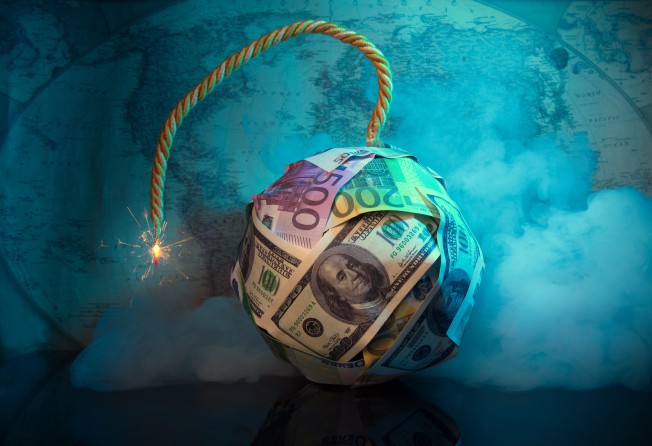Central banks riding to the rescue of crashing debt markets must think twice
- Aside from the moral hazards of such a massive bailout, the risk is that a wall of central bank money meeting slumping growth and output can cause the greater damage of hyperinflation

Financial markets are, to quote one seasoned and expert observer, “in full-blown panic mode” while the United States Federal Reserve and other central banks are poised to go into full-blown lender-of-last-resort mode. All this is being blamed on the coronavirus pandemic but in truth it is (yet) another financial market crisis.
Asset markets have long been primed for a crash and now it has come, with US stocks back in bear market territory after suffering their worst one-day slump in more than a decade, despite supposedly calming actions by the Fed and the European Central Bank. Coronavirus was the trigger but not the cause.
More worrying than the long-overdue correction to equity values is that the US Treasury market – the fulcrum of global financial market liquidity – is showing signs of seizing up. That would provoke a systemic financial crisis perhaps worse than in the 2008 financial crisis.
It will not be allowed to happen (for now, at least) because the Fed will be forced to step in and reliquefy it, “thus aggravating the moral hazard it has been running for some time”, as Hung Tran, a former senior official at the Institute of International Finance, put it to the Post.
In effect, this means the Fed will underwrite the risks of a market which has exploded in size since the global financial crisis, along with the massive growth in US corporate debt. The value of much of this debt is predicated upon faith, rather than underlying assets.
Central banks are already preparing to underwrite or monetise huge volumes of government debt as calls for fiscal stimulus to offset a feared global recession reach a pitch. This game will have “consequences” and not too far down the road.
As Tran, now a non-resident fellow at the Atlantic Council in Washington, said, there has been a “noticeable deterioration of liquidity amidst rising volatility in the US Treasury market, [which is] the risk-free benchmark for the pricing the world’s fixed income market”.
The “predominance of superfast electronic trading platforms including high frequency traders has led to a lack of depth in the market”, he said, while big debt positions built by institutional investors on the back of low interest rates have also made the Treasury market susceptible to flash crashes.
Or as Harvard fellow Paul Sheard, S&P’s former chief global economist, said: “US Treasuries are the world’s ‘safe asset’ and are used as collateral in all kinds of financial transactions.” Market liquidity is not a fixed quantity but depends entirely on buyer and seller sentiment.
It is nice to think of central banks as benevolent institutions with infinite resources ready to ride to the rescue whenever a financial crisis threatens, and ready to regard the financial excesses that provoke the need for rescue with a kind of avuncular indulgence.
Such attitudes have been encouraged by the emergence of so-called modern monetary theory, which teaches, in effect, that governments can simply write a cheque drawn on their central bank to finance fiscal stimulus when other forms of monetary stimulus become ineffective.
Setting aside the merits or otherwise of such arguments, central banks in the world’s leading economies face the prospect of having to monetise huge volumes of not only government debt, but also corporate, and maybe even household, debt too.
As former International Monetary Fund chief economist Maurice Obstfeld said: “After a decade of slow growth and low interest rates, the world is awash in debt, issued by households, corporations and governments. It is tempting to believe that much higher debt levels are sustainable indefinitely.”
But they are not. First, the Trump trade wars and now the coronavirus crisis are threatening to bring on a global recession, which in turn threatens massive debt defaults and financial institution failures unless central banks underwrite them by embarking on massive reliquefying and support programmes.
They will almost certainly do so and it might be supposed that, as with modern monetary theory and fiscal manoeuvring, such an unprecedented bailout can be accomplished with minimal shock to the system and relatively little pain to consumers and investors.
But aside from the massive moral hazard implications of such scenarios, the risk is that a wall of central bank money meeting slumping global growth and output can cause inflation to rise exponentially. Initial deflation, as asset values slump, could then give way to hyperinflation.
We can only hope that the coronavirus crisis subsides rapidly, allowing human activity and economic output to return to something like normal before long. That would allow the system to stabilise somewhat, if only at lower output levels.
But the mood of panic in financial markets, matching public panic over the threat of catching the coronavirus, does not augur well. Maybe the mere promise of central bank support may calm nerves – but let us hope that such support does not need to be forthcoming.
Anthony Rowley is a veteran journalist specialising in Asian economic and financial affairs